Canberra's amazing one-night-only medieval Good Food Feast
The Society for Creative Anachronism stage a feast like Canberra has never seen before. This is a dinner date one can't refuse.
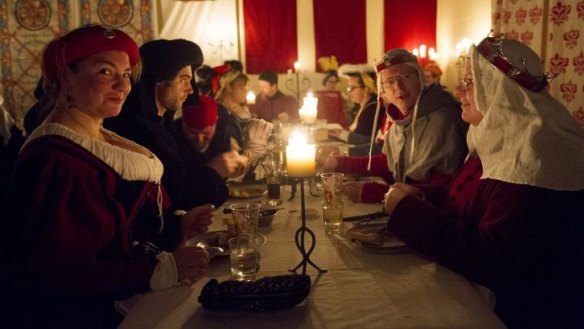
It's almost time. The goose is roasted and waiting for its green garlic sauce. The small bird pies are ready. The smoked pressed tongue needs to be plated. Freshly baked twists of bread are piled high in big tubs. In the dining hall, the walls are covered with floral hangings, the ceilings are draped with blue fabric covered in stars, and the room is filled with candlelight. The servers, wearing red-and-white tabbards, are setting places at the long banqueting table.
This is the Good Food Feast - a medieval banquet on a magnitude that's perhaps never been seen in Canberra before. Members of the Canberra branch of the Society for Creative Anachronism have spent long hours transforming this church centre in Hackett into a lushly furnished medieval hall. Outside, a row of embroidered pennants flutter in the evening breeze, and a couple of young folk, dressed in simple robes and tunics, are lighting candles on the pavement to guide the guests towards the hall. A year's worth of work has gone into this one night.
It's an attempt to recreate a similar Good Food Feast that was held 20 years ago in Canberra, which raised the bar for the creative anachronism society, taking the food from bulk catering to fine dining. This time around the Canberra society has set the challenge of preparing a 16th-century feast from the German and Dutch low countries.
"What we do in the society [is] experimental archaeology," says Michelle Dean. Her "SCA name" is Mistress Francesca Cellini and we're sitting in the living room of her north Canberra home with crackers and dips set out on the coffee table. It's a week before the feast. Dean talking about recreating the past in small pieces, which is the task that absorbs and occupies members of the society. They make armour at home by testing and re-testing ancient techniques or painstakingly recreate an elaborate gown based on nothing more than a portrait of a great lady in a museum. The Canberra society's president, Brigid Costello (aka Baroness Anne de Tournay), who's settled on the sofa, calls it "social living history". Her people are intrigued by history and obsessive about research. "I often joke that if you are madly passionate about Armenian beekeeping in the 13th century - we've got 70,000 members worldwide. We can find you someone to talk to," she says.
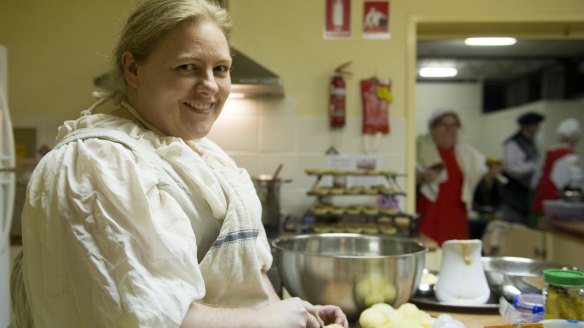
On the coffee table before us is an example of that obsessive research - a baking tray with half a dozen roast goose legs and a tub of green sauce. Head chef Trudi Lynch (Baroness Gertrud von Ritzebuttel) has prepared the goose legs as a trial for the Good Food Feast, and she wants our opinion on the green garlic and sorrel sauce.
So how do you prepare an authentic 16th-century banquet? First you have to find a cookbook or a text that has recipes from the correct period. Then you have to translate them accurately from say, medieval Dutch to English. Then you have to translate the recipes again for modern cooking. "The recipe might say 'Take a goodly amount,'" Costello explains. "'Cut it into gobbets.' How big is a gobbet?" Dean remembers trying to cook ancient recipes from photocopies of old texts, making notes as she went along.
Now the internet, of course, has boosted SCA research capacity hugely. People can post recipes, along with their research and notes, and photos of each step of the cooking process. But this also means the stakes are higher for the Canberrans as they seek to put on a "once in a lifetime" feast. "The opportunity to push the envelope is that much greater," Dean says.
The final problem is trying to translate the dish for the modern palate. For instance, Costello says 90 per cent of the dishes from the period consisted of meat cooked with fruit - a mix of savoury and sweet that many modern diners find hard to accept. Some people can't stomach tongue, or liver, or duck's feet. "Food at that particular time was also linked to medicine," Dean says. "So the menu you ate was dependent on your physical wellbeing." The combinations of sweet, sour and savoury were designed to boost your health.
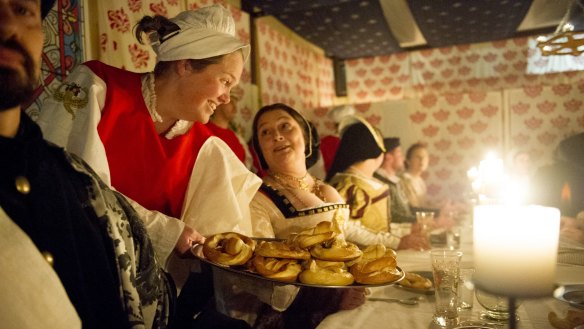
And after all that - it's still got to taste good. Lynch trained as a chef and works in IT. One of the dishes on her menu is a series of "small bird pies" filled with layers of quail, pigeon, bacon and grapes. "It's a very easy recipe, because you take the bird, you add some bacon and a bit of butter, you take some grapes, you wrap it in pastry and you cook it," she says. But she still has to adapt it to modern sensibilities - in this case by changing the structure of the pies. "If you take a pie and there's something in it that's not edible like a bone, people freak out," she explains. "So if I'm making a pie, even though I know that in a medieval sense they would have cooked the bones in it, for the extra taste and the body, for the modern palate there needs to be no bones."
By now everyone has had a goose leg - they're firm, darkly roasted on the bone and satisfyingly meaty. But the green garlic sauce, we all agree, doesn't have enough of that garlicky tang. Lynch will need to boost the garlic again before the feast night. She opens up her laptop and shows me her recipe notes - the original recipes she's drawn from, the translations, a potted summary of each test run, all the changes she's made, notes on timing, and guides on how to scale up the recipe. At the end of the feast, she will post the whole package onto the internet so other cooks in other societies around the world can put together a banquet of their own. It's gloriously detailed and unashamedly geeky.
On the day of the feast I get to the hall in the afternoon. The kitchen and prep area is stacked with food - huge twists of bread in tubs, Tupperware containers filled with scallop shells, piles of serving ware, and cloaks heaped on chairs. Trudi Lynch is the commander in the small square kitchen. Everyone is in period costumes. A man who will be known through the evening simply as Dickon puts wood into braziers in the courtyard for the live entertainment that will happen between courses. A trio of musicians practise in the dining hall as servers set the table. There is just so much detail. The plates and cutlery are hand made for the occasion out of stainless steel. The napkins have been sewn by a member of the society. And the glasses have been hand painted with the society's logo.
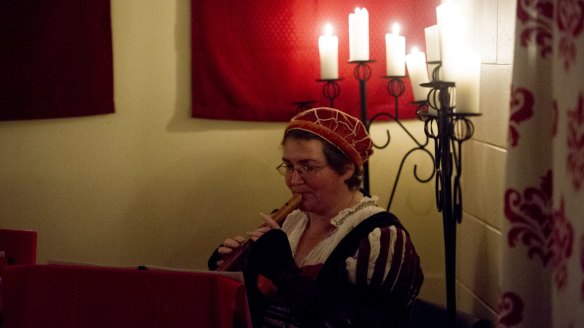
With 10 minutes to go, the cooks head off to get properly dressed and candles are frantically lit everywhere. Michelle Dean leans over a side table, reading through her run sheets and lists one more time. The servers get their final instructions ("talk to your people because we don't know where the allergies are"). And out in the courtyard the guests arrive, stepping incongruously out of taxis and into a whole new life. There are grand Tudor ladies, elaborate headdresses, Russian nobles, sweeping skirts, and so many cloaks, gathered around the lit braziers. Everyone is inexplicably carrying picnic baskets. The dinner is completely sold out - there were just 68 places available - and some people have flown in from interstate or driven down from Sydney just for the event.
Here is how you start the Good Food Feast. Someone ceremoniously announces your name to the crowd, a server pours water from a jug over your hands to wash them, and you're led to your seat. Lord Otto Sexeburger (Benjamin Norman) sits down beside me with a big picnic basket which he busily unpacks onto the table. He's brought a napkin, extra plates and several knives and a fork. Around the room, everyone else is doing the same, unloading plates and cups and linen. I am the only person who has not brought backup cutlery in a wicker container.
It is truly beautiful in the banqueting room - the golden glow of candles, the scarlet and deep blue hangings, the gorgeous costumes. And then the food starts to come out, tray after tray of stuffed eggs with slices of pressed tongue, twists of bread threaded onto a wooden stick. The servers don't break character. "Veal with pepper sauce or blood red sauce, my lord," they murmur, presenting a tray of tender slices of meat and pots of condiment. The veal is perfectly cooked, juicy and soft, the accompanying "blood red sauce" a little sweet and the pepper sauce mild. There is spiced wine, chosen to best represent the styles of wine made in the Low Countries at the time, and plenty of antique cordials, including a sweet, refreshing elderflower drink.
Norman is cheerful, voluble guy in his 30s with a dark beard and glasses. He talks about what he does in the "mundane world" (the modern world) and what he does in the SCA world. He's a knight and a very keen sword fighter who makes his own armour, studying ironwork techniques and researching fighting styles. Brigid Costello is his consort - which does not mean his partner. "Milady Anne is a very good friend," he explains. "But after my partner and I split up I still wanted to remain involved in the SCA and so you ask someone you know to be your 'consort' so you can have someone to fight for symbolically in tournaments, that sort of thing." His new girlfriend lives interstate, so Costello is still his SCA consort. We talk about dating while creatively anachronistic - how it can be a bit tricky to bring up your medieval hobby on a date and whether you should mention it on Tinder ("no, it's not LARPing! Or Lord of the Rings!" He rolls his eyes).
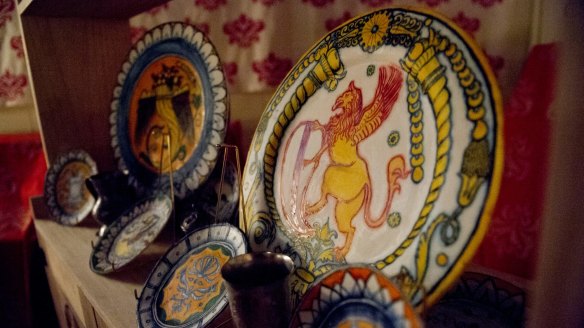
While we talk, we eat - joining the beautifully dressed guests lifting their glasses for wine, sharing choice tidbits of food and gossip. The pressed tongue is meltingly tender and easy to eat, good to wrap around a chunk of golden-brown bread. There are eggs filled with a soft herby mash and pickled vegetables and beetroot cut into the shape of a cross and seasoned with honey. I get a particularly tough goose leg and have to borrow one of Otto's big knives to saw at it, but the green garlic and sorrel sauce is quite garlicky. A plate of scallops on delicate, gleaming pastel shells is passed around.
Our neighbour Daniel De La Guerre (university student Daniel Thomson) takes a careful look at his scallop. "It's a subtlety," he declares. A subtlety is a sort of trick dish and these are worthy of Heston Blumenthal - the scallop meat is actually almond jelly and the shell is made of crisp sugar and scented with rosewater. Those small bird pies are very satisfying - wrapped in thick pastry and full of sweet, yet meaty flavour. No bones. Lord Otto is gluten-free so I even get to eat his pastry shell too.
In between courses the assembled lords and ladies head out to the wintry courtyard to see live entertainment: a tableau of Salome holding the head of John the Baptist on a silver platter, a very lively puppet show based on the story of Lady Godiva, complete with in-jokes about pelicans and dirty jokes about convents and nuns, and a performance involving Adam, Eve and a giant plush toy snake in a distinctly modern, two-dollar-shop shade of hot pink. It's freezing. I'm glad that I'm wearing faux fur, a wool undershirt plus some fleecy tights under my wide velvet skirt.
All night long people have come up to say how beautiful my costume is. "I'm dressed by Mistress Rowan," I tell them immediately. Viscountess Rowan de Peregrynne (Robyn Spencer) is the owner and creator of this elaborate black-and-gold 16th century Saxon outfit, complete with a lavish faux fur collar patterned in gold thread. There's also a hat with a two-foot long feather in it. She's a legendary figure in Australian medieval circles (the Sydney society is even named after her).
There are three of us wearing her borrowed costumes tonight, including a woman in a brilliant ruby red gown intricately studded with pearls. Costello has shown me the trick to walking in a floor-length skirt - kicking your feet out every time you take a step. There's a grand sense of occasion about wearing a dress like this, even if you do have to walk a little like a petulant six-year-old. Even the simple act of tilting your head to listen to someone talk acquires an arch gravitas when you've got a hat on your head.
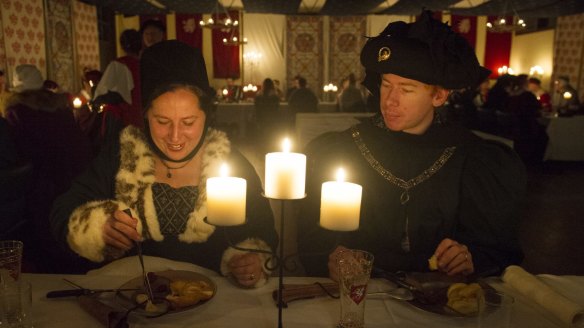
The last course is pies filled with jellied red wine, cinnamon and fruit and buttery pastries served on colourful small plates - which are made out of sugar. "You may eat your plate when you are done with it, my lady," says one of the servers. It is too beautiful. I can't. There are also a selection of fresh cheeses (Neufchatel and blue) which have been handmade by Lord Otto. He is not impressed. "Argh, this is one of the bad ones," he groans, stabbing a knife into a chunk of cheese and tasting it. It's crumbly, soft and tangy, possibly a little salty. He explains that one set of cheeses didn't quite turn out the way he wanted. Luckily the good set is circulating somewhere on the other side of the room.
When the fluorescent lights eventually come on, breaking the spell, it is nearly the witching hour. This is the bit where we could just be a bunch of public servants and uni students wearing costumes in a rented neighbourhood hall. But no. If anything, the pretty gowns and dramatic cloaks are even more detailed under bright light and everyone swirls towards each other, laughing, chatting and slowly packing their picnic baskets. Brigid Costello, who has been here with the rest of the servers since the morning and still has hours of packing up to do, catches me to ask if I've had a good time. It's been brilliant, I say. Everyone is so lovely. But does she think they've succeeded in raising the bar for a medieval feast? She looks at the still-crowded dining room. "It's actually a bit unusual to see everyone still here talking - usually they pack up quickly and take off because it's quite late," she says. "But they're hanging around." It's like they don't want it to end.
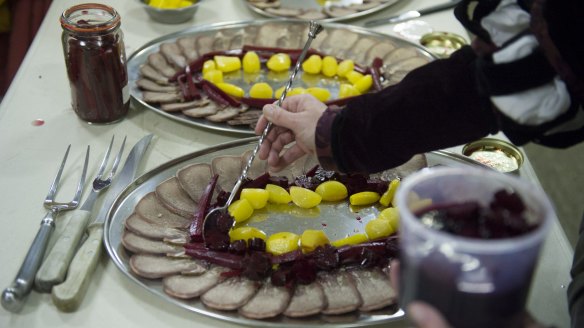
The Good Food Feast menu
The first course
Eggs stuffed with spiced herb mash
Smoked pressed beef tongue
Pickled vegetables with honey and saffron
Freshly baked bread
The second course
Baked salmon, served on crisp rye pastry
Spinach cooked in the Hungarian manner
Oysters with flowers of lemon
Golden scallops
Goose with green garlic sauce
The third course
Small bird pies
Veal with yellow pepper sauce, mustard or blood red sauce, served on a bed of picked cabbage with white sausage and beetroot, and carrot, almond and violet mash
Dessert
Red wine, cinnamon and plum tarts
Malavosia pear tarts
Spanish sweet almond and butter pastries
Hand-made cheese with crisp Gouda biscuits
Natasha Rudra was a guest of the Canberra Society for Creative Anachronism. See sca.org for more.
Restaurant reviews, news and the hottest openings served to your inbox.
Sign up